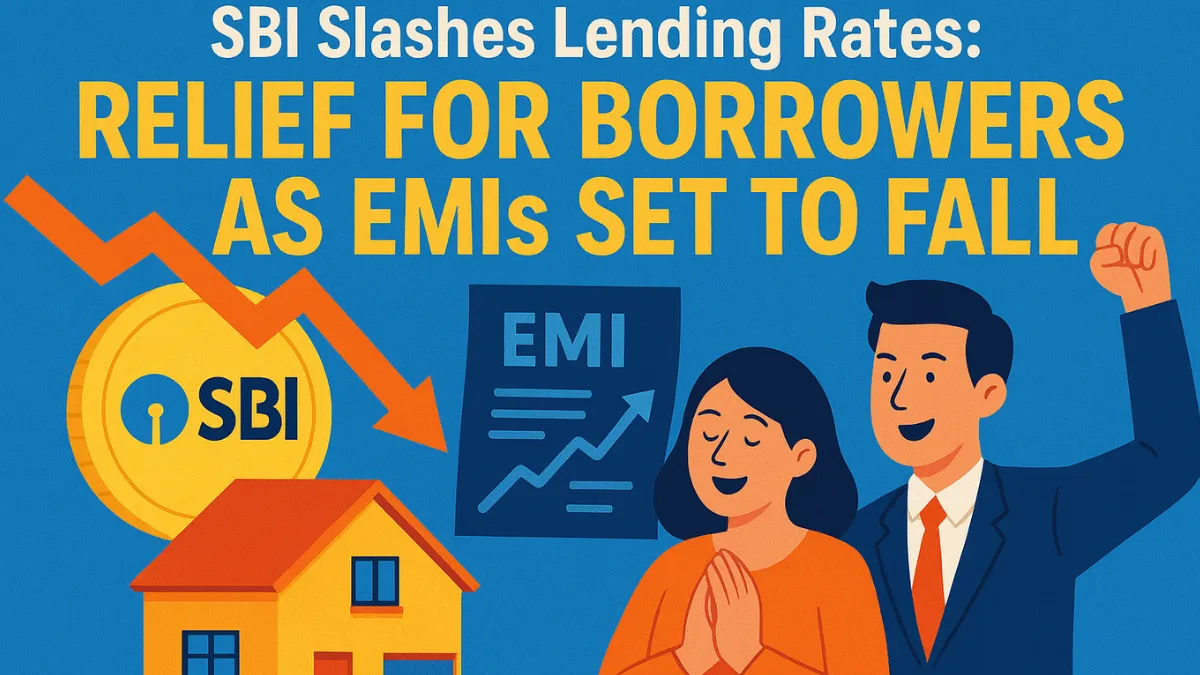SBI Slashes Lending Rates, bringing much-needed relief to millions of Indian borrowers as EMIs on home, auto, and personal loans are expected to fall. On July 15, 2025, the State Bank of India (SBI) — the country’s largest public sector bank — announced a reduction of up to 25 basis points (bps) in its Marginal Cost of Funds-based Lending Rate (MCLR) across different loan tenors.
The bank’s decision is poised to reduce the repayment burden for existing borrowers and may also boost new loan demand in sectors like housing, education, and business. The move is being seen as part of a broader push to stimulate the Indian economy amid stable inflation and softening global interest rate trends.
Revised MCLR Breakdown
SBI Slashes Lending Rates, Here’s how SBI’s updated MCLR structure looks:
- Overnight MCLR: 7.85% (down from 8.10%)
- One-month MCLR: 7.95% (down from 8.20%)
- Three-month MCLR: 8.05% (down from 8.30%)
- Six-month MCLR: 8.30% (down from 8.50%)
- One-year MCLR: 8.65% (down from 8.90%)
The one-year MCLR is particularly important, as most retail loans — especially home loans — are linked to this rate. The lower MCLR will automatically reduce EMIs for borrowers whose loans are set for interest rate revision.
Home Loan Borrowers: Big Winners
For home loan borrowers, this rate cut could translate into significant savings. Consider this example:
- A ₹40 lakh loan for 20 years at 8.90% would have an EMI of ₹35,790
- At the new 8.65%, the EMI drops to ₹34,905 — a monthly saving of ₹885, or ₹10,620 annually
Borrowers with floating-rate loans linked to MCLR will benefit at their next rate reset. It also improves affordability for new buyers, potentially boosting demand in the real estate sector.
What It Means for Other Loans
- Auto Loans: While many new auto loans are repo-linked, older ones tied to MCLR will become cheaper.
- Education Loans: Students and parents may find education loans more affordable if linked to MCLR.
- Personal Loans: Limited impact, as these are generally at fixed rates or linked to external benchmarks.
Why Did SBI Cut Rates?
Several macroeconomic and competitive factors likely influenced SBI’s decision:
- Stable Inflation: With CPI inflation under 5%, there is room to pass on the benefit of lower cost of funds to consumers.
- Encourage Credit Growth: The economy thrives on credit. A rate cut could push more people and businesses to borrow.
- Competitive Market: SBI faces intense competition from private banks and NBFCs offering repo-linked loans.
- Growth Support: RBI has maintained a neutral stance, but rate cuts from banks can independently boost economic activity.
Repo-Linked Loans vs. MCLR
Most new loans are linked to the Repo Linked Lending Rate (RLLR), which changes directly with RBI’s repo rate. MCLR-linked loans, however, change at fixed intervals — such as annually — and are more stable in the short term.
If your loan is still MCLR-linked and you’re nearing the end of the reset cycle, now is the perfect time to renegotiate or refinance at lower rates.
Broader Economic Impact
The lending rate cut is expected to ripple through multiple sectors:
- Real Estate: More affordable EMIs could trigger new home purchases.
- Consumer Goods: With lower interest outgo, consumers may have more disposable income.
- Business Growth: MSMEs and corporates can access cheaper loans for working capital or expansion.
If other banks follow SBI’s lead, it may spark a credit growth cycle — a good sign for GDP acceleration and job creation.
Caution for Borrowers
While this is a welcome move, borrowers must stay aware of the following:
- The rate cut only benefits MCLR-linked loans.
- The EMI reduction only applies after the reset date, which varies from borrower to borrower.
- Those on RLLR loans won’t benefit from this unless RBI cuts the repo rate.
Borrowers should also explore loan refinancing if better rates are available or consider switching to repo-linked loans if their profile allows.
Conclusion
SBI’s decision to cut lending rates is a positive signal for both consumers and the economy. It’s a move that supports financial inclusion, promotes spending, and could lead to broader interest rate moderation in the banking system. Borrowers should stay informed, track their loan terms, and seize the opportunity to save more in the months ahead.








